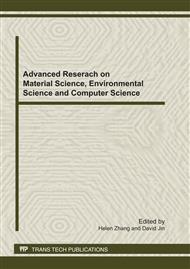p.337
p.341
p.345
p.349
p.353
p.357
p.361
p.365
p.369
A Numerical Simulation of Diffusion Experiment in Clay
Abstract:
Safety assessment of nuclear waste disposal in a deep geological repository requires understanding and quantifying radionuclide transport through the hosting geological formation. Determining diffusion parameters under real conditions is necessary for the performance assessment of a deep geological repository where high level wastes are placed for safety disposal. The in situ diffusion and retention (DR) experiments are designed to study the transport and retention properties of the Opalinus clay formation. In this paper, a scoping numerical simulation is performed in Opalinus Clay, The simulated results for all the traces illustrate that the maximum transport distance perpendicular to the bedding is larger in the isotropic case and those along the bedding is larger in the anisotropic case. Tracer depletion in the isotropic case is a little larger than in the anisotropic case. Deuterium and iodide can be detected in the other interval but strontium can’t. Since the length of injection interval is shorter than the transport distance, the anisotropy effect is clearly measurable. This numerical simulation of diffusion experiment aims at contributing to the optimum design of the experiment. The results of this experiment will provide additional insight into the role of diffusion anisotropy and sorption parameters for radionuclides in clays.
Info:
Periodical:
Pages:
353-356
Citation:
Online since:
August 2011
Authors:
Price:
Сopyright:
© 2011 Trans Tech Publications Ltd. All Rights Reserved
Share:
Citation:


